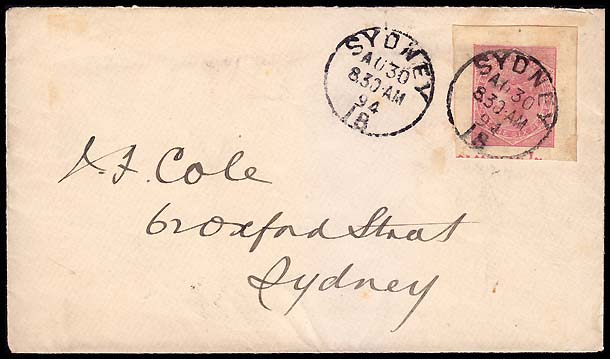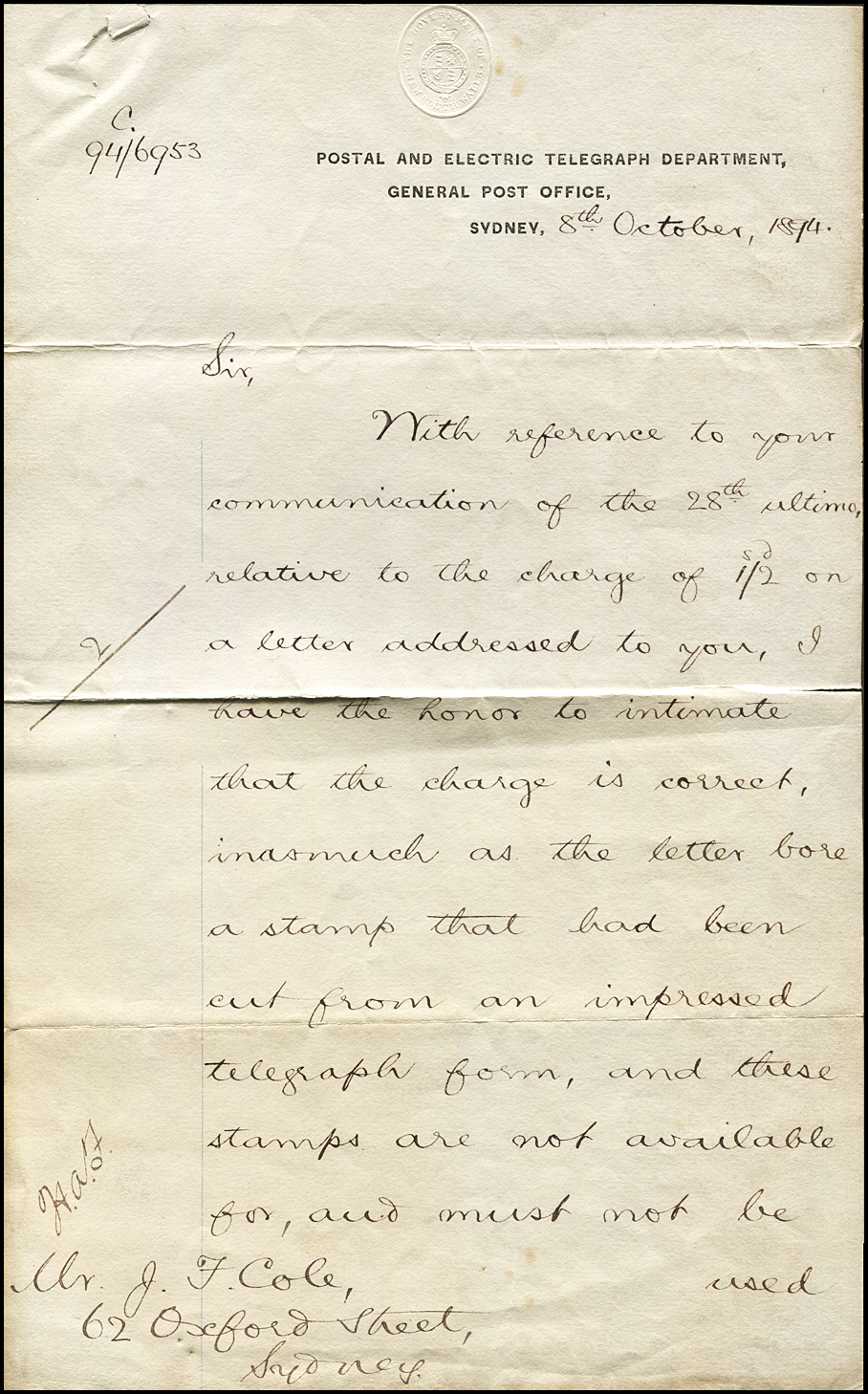The illegal uses of the two indiciums for postage.
- Australia 1901-1988
- New South Wales
- Overview of NSW
- Telegraph lines
- Telegraph Offices
- Date stamps
- Forms
- Envelopes
- Instructional annotation
- Collect
- Delayed
- Free
- Immediate Urgent
- Reply paid
- Rates
- Stamps
- 1871 Telegraph stamps
- 1885 proposal
- 1893 proposal
- Queensland
- South Australia
- Tasmania
- Victoria
- Western Australia
- International
- Special aspects
Although the respective indiciums were to remain on the transmission form, some people saw an opportunity to defraud the Post Office by cutting the indiciums off and affixing them to envelopes to post. Clearly that was an illegal practice. The March 1895 Post Office Monthly Circular for example, stated that "the stamps imprinted thereon (the forms) are not recognised for any other purpose".
Relatively few examples are known of this practice and most of these examples are posted to local destinations for which the rate was 1d not 6d. Almost all known examples are addressed to J.F. Cole or to his address (about that date) in 62 Oxford Street or at the London Bank. It appears as if only one example was caught by the authorities.
The examples are provided below according to:
- 6d as a folded form;
- 6d on an envelope;
- use of the 6d indicium which was intercepted by the Authorities.
- 6d on an envelope in a mixed franking;
- 1/- on an envelope as a local letter;
- 1/- on an envelope in a mixed franking;
- both indiciums on an envelope.
The most remarkable example of the incorrect use of the transmission form with the 6d rose indicium is where the form was simply folded and sealed.
 Provenance: Gundersen, Johnstone. Prestige Philately 2006 Sale 123, lot 496. |
Cancelled with a SYDNEY NSW duplex of 1 September 1894. |
 Reverse side of the Jones letter showing the folded form sealed with red wax seals. |
 |
| A folded paper inside the sealed form to make a letter with bank instructions. |
A number of examples (less than 10) exist of the 6d rose stamp image being cut from the form and affixed to an envelope to pay postage costs.
 |
Sydney date stamp of 30 August 1894. For local delivery to J. F. Cole on Oxford Street. Two strikes of the date stamp - at 8:30 am.
|
 Gartner Store Sale April 2024, Lot 2038. |
A second example to the same addressee and on the same date but at 7:00 am.
Cancellation is with a Sydney duplex. |
Use of the 6d indicium intercepted by the authorities.
A long cover was addressed to J. F. Cole in Oxford Street and a 6d rose indicium glued on the the cover. It was cancelled on 27 September (?) 1894:
When the Postal Authorities identified the incorrect use:
- they calculated a fine for Deficit Postage as determined by 2d per 0.5 ounce (double normal rate). As the envelope weighed 3.5 ounces
(see blue mss to left of FINE), the total was 1/2 which is shown next to the Deficit Postage handstamp with 1/2 ms in blue. - a single and a block of 6 2d postage dues were affixed and then crossed in blue crayon.
 |
|
 |
(left): a detail of the affixed indicium showing the manuscript ILLEGAL. |
Mr Cole complained about the fine.
After a review of the case, the Deputy Postmaster-General (Mr. S. H. Lambton) sent a letter to Mr Cole informing him that concerning that the Postmaster had reviewed the case and was prepared to refund 1/- of the postage due fine. The charge of 2d for the underweight franking remained however. The Lambton letter is shown below:
 |
 |
6d on an envelope in a mixed franking.
 Provenance: Provenance:Prestige Philately April 2009 Lot 435. Millennium Auctions November 2019, Lot 110. |
Carrathool to Hay NSW (about 64 km apart). 30 October 1895. Mixed franking with a 1886 3d green Diadem (perf 11 × 12). Franking overpays the 2d intra-colonial rate plus the 3d registration fee. Has a Hay arrival backstamp of 31 October on the reverse side with an embossed FAMILY HOTEL etc inscription on the flap.. See also the corresponding 1/- cover below. |
1/- on an envelope as a local letter.
A 1/- black indicium was cut from a transmission form and affixed to an envelope to pay the registration and postal cost for a local letter.
Normally the cost would be 1d. local postage rate and 3d Registration fee.
 The only recorded use of a 1/- indicium used to pay local postage costs. |
Park Street to Oxford Street 27 August 1894. Used in the same month as the Specimen overprints were issued.
|
 |
Detail of the indicium and date stamp. |
1/- on an envelope in a mixed franking.
 |
Carrathool to Hay NSW (about 64 km apart).
30 October 1895. Mixed franking with a 1886 3d green Diadem (perf 11 × 12). Franking overpays the 2d intra-colonial rate plus the 3d registration fee. Has a Hay arrival backstamp of 31 October on the reverse side with an embossed FAMILY HOTEL etc inscription on the flap. |
 |
Detail of the indicium in the mixed franking.
See also the corresponding 6d cover above. |
Both indiciums on an envelope.
Only one example is known of the two indiciums on one cover.
 |
The cover addressed to J. F. Cole at the usual Oxford Street address in Sydney. Cancelled with a Sydney NSW duplex. |
 |
Detail of the two indiciums and the date stamps. |